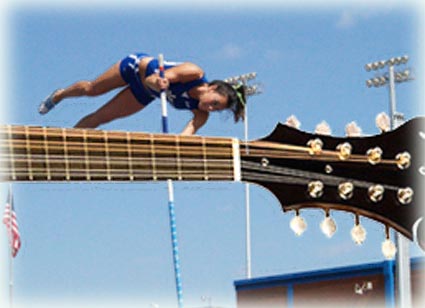« Guitar to Mandolin |
Main
| Deconstructing Mandolin Picks »
 June 3, 2010 | Making sense. More than five senses? June 3, 2010 | Making sense. More than five senses?
We all grow up with the notion that we have five senses. Sight, hearing, taste, smell, touch. There is always an added ethereal reference to a sixth sense, tons of movies and books have been written about this tantalizing phenomenon, but what many may not be aware of, physiologists have even expanded these senses to as many as nine to twenty-two, although categories can blur, and some of them involve non-human ones, for example a bat's radar (echolocation).
The additional human ones are interesting. You have balance and acceleration, also known as equilibrioception whose organ is the vestibular labyrinthine system found in both of the inner ears. Some of us are good, some are lousy, as failed experiences with pole vaulting in childhood can reveal. You also have the thermoceptors in the skin yielding a sense of temperature, different from the homeostatic ones in the brain (hypothalamus) which provide feedback on internal body temperature. Direction, magnetoception (or magnetoreception) is the ability to detect the direction one is facing based on the Earth's magnetic field. Directional awareness is most commonly observed in birds, though it is also present to a limited extent in humans. If you've ever arrived at a destination on a cloudy day or at night, sometimes you still have a feeling where north is, devoid of the sun.
Nociception or physiological pain signals near-damage or damage to tissue. The three types of pain receptors are cutaneous (skin), somatic (joints and bones) and visceral (body organs). Of course these are important signals for a player to recognize; pain is a message not to ignore.

Also, relevant to mandolin playing, proprioception or Kinesthetic sense, provides the parietal cortex of the brain with information on the relative positions of the parts of the body. The notion that if you close your eyes, with this sense you can touch your index finger to your nose. You use this when taking your eyes off the fingerboard, and developing an important kinesthetic sense of finger and pick position. It's more than just touch, it's a fretboard GPS.
Others that aren't commonly covered in physiological studies but are very important to playing are senses involving rhythm, pitch, harmony, and melodic distinction. Certainly, we all have varying degrees of abilities here, some may have perfect pitch, the awareness of A440 or any other pitch at any time. Some are blessed with good relative pitch and while the former is something you are born with, the latter is one you can develop over time.
Sense of rhythm should be included, too. You know musicians who have developed incredible time; some seem to take this gift to new dimensions. There's nothing like playing with a good drummer with a finely honed awareness of time.
Some have a knack for hearing chords, some are better at melody. It's a vertical verses horizontal sense, and it's interesting how some musicians are all about the chord and harmonic progression (likely attracted to jazz) and some can memorize and repeat melody in vivid and intricate detail. Those who can internalizes lengthy, complex phrases are probably highly attracted to the intricacies of Celtic or Balkan music and other sophisticated folk genres.
We call it "playing." It should be that. You can get the best enjoyment out of discipline and developing these additional senses through exercises and listening, but be aware that humans are as different and individual as snowflakes, and we will each have different access to skills within the palate of senses. Work on weaknesses certainly, but at the same time, recognize and bask in the aptitudes you are blessed with as a player, the gifts God gave you.
We're going to go work on ours with a little FFcP now...
Further:
Fingers, Ears, Brain
Four Finger Closed Position FFcP
Chords in the fingers. Chords in the head.
Dr. Mao: Four Exercises to Sharpen Your Brain.
Starting, Stopping, and That Stuff in the Middle.
Posted by Ted at June 3, 2010 2:50 PM

Disclaimer: In the 'Information Age' of the 21st Century,
any fool with a computer, a modem, and an idea can
become a self-professed 'expert." This site does not
come equipped with 'discernment.'
|



